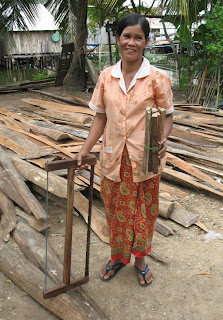
Update on Him Sar
Entrepreneur: Him Sar
Entrepreneur: Him Sar
Location: Muk Kampoul district, Cambodia
Amount Repaid: $42.00 of $500.00
This entrepreneur is funded by a Kiva loan administered by Maxima Mikroheranhvatho Co., Ltd. here in Cambodia. Him lives in a small village along the Mekong River about twenty kilometers north of Phnom Penh. His loan is being paid off on schedule.
Him, age 42, has been fishing since he was a young boy. He used the funds from this loan to buy a fishing net and to continue repair work on one of his boats. Him and his wife have five boys all of whom fish with him. Three of them study in the village school, as well.
Him explained that he does all of his fishing in the Mekong, which abuts the rear of his yard. He had two boats moored to the shore and a third, under renovation, up on supports behind his house. Like many Cambodians, Him is a model of self sufficiency. He not only fishes and maintains all his gear, he builds and, in this case, re-builds his boats himself (see photo). At about eight meters or more, the boats are not small craft either. His renovation project looked like a something a professional boatwright might spend months completing. Him said he’d have it complete by the beginning of the fishing season in January, though.
As the loan officer and I sat on the floor of his house, Him and his wife mended nets, a task that he explained is never ending. If you use a net, it gets damaged. If it’s going to work, it needs to be fixed so it has no holes. I felt like I was underdecks on an old pirate ship. Their house, like all houses in this area, is built on stilts because of flooding. Through the open, rear window we looked directly onto the Mekong. Just after we sat down, though, a fairly large bird hopped down from where it was resting on a basket handle and jumped across the nets to get a closer look at me. It seemed so curious, we wondered if even the bird could tell I wasn the sole non-Cambodian.
Him and his sons fish using large nets. He said a typical net is 150 meters long and 45 meters deep. They take two boats out into the river, float parallel and start to feed the net into the water in between. When the net is fully extended, the current bends it into a huge “C” shape. They leave it there for about two hours before closing the ends together and hauling it in. On a good day, Him said they can bring in 2000 kilograms of fish! I was astounded, but began to understand as he went on to explain. They catch three types. The largest is the size of a man’s thumb; the smallest the size of a pinky finger. For a kilo of these fish, Him can get between 200 and 500 Riel (US $0.05 and $0.13). He sells all he can at the local, district market. Whatever is left, he sells to people who make what Cambodians refer to as “cheese”. The fish are fermented en masse making an extremely pungent and long-lasting pâté called “prohok”.
Him also explained that the catch from the Mekong has been diminishing every year for the past ten years or so. He showed us what is believed to be the cause. Until the last two fishing seasons, people used nets with a mesh only 3-4 millimeters wide. Virtually no fish, including hatchlings, escaped. Fish the world over is one of the cheapest sources of protein. Cambodians, blessed with very rich fresh water lakes and rivers, get more than sixty percent of their protein from fish. When the fishermen noticed that catches continued to fall, the government outlawed the small mesh nets. Him said a new net can cost between $1,000 and $2,000. Few people here can replace such a piece of equipment at the drop of a hat so it has taken – and will take more – time before the old nets are purged. Him hopes the fish population will rebound to its old levels. (I think I now understand why hammocks and sun-shades made of fine netting are so ubiquitous here.)

.jpg)
.jpg)





.jpg)

.jpg)



.jpg)
.jpg)


.jpg)


.jpg)
.jpg)
.jpg)


.jpg)